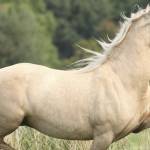Check Mares with Too Many Heat Cycles

Most mares of breeding age begin to cycle into heat in late winter or early spring. A shift in hormone production that causes these periods of reproductive receptiveness is triggered by more hours of sunlight during the increasingly longer days as winter ends.
If a mare is not bred and doesn’t become pregnant during a heat cycle, she will usually continue to show signs of estrus about every 21 days through the spring and summer. When the sunlight hours shorten in the fall, most mares enter an anestrous period when they do not show regular signs of heat.
Mares that continue to come into heat or have more frequent heat periods may be suffering from ovarian tumors, infection, or other disease conditions. A veterinary examination can uncover these problems that may affect breeding soundness.
Some mares seem to be in heat almost constantly, especially when they are at a show or other performance event, and their skittish behavior and inability to pay attention are the bane of an owner’s competition plans. If a veterinary examination does not turn up any sort of physical abnormality, the owner may choose to begin hormone therapy to smooth out the mare’s behavior. A recent study at Colorado State University showed that this type of therapy had no negative impact on a mare’s future reproductive health.








